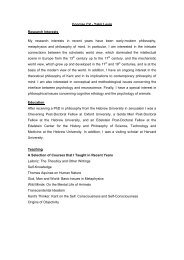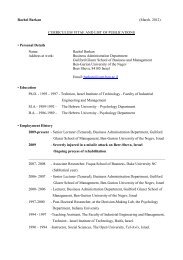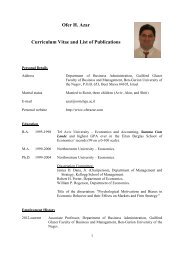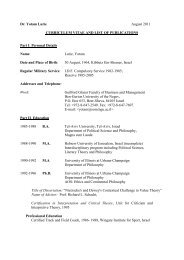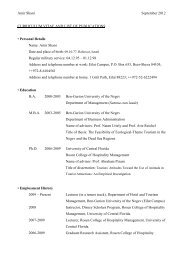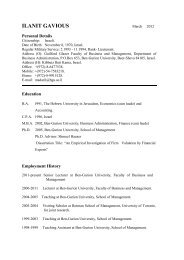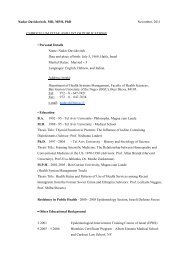Book of Abstracts
Book of Abstracts
Book of Abstracts
You also want an ePaper? Increase the reach of your titles
YUMPU automatically turns print PDFs into web optimized ePapers that Google loves.
Piloting water sensitive urban technologies in Israel; 1 st pilot in Kfar-Sava<br />
24<br />
Y. Zinger 1* , A. Deletic 1 , T. D. Fletcher 1 , Asher Brener 2 , T. Wong 1<br />
1<br />
Centre for Water Sensitive Cities, Department <strong>of</strong> Civil Engineering, Monash University, Victoria, Australia, 3800<br />
2<br />
Biotechnology & Environmental Engineering, Faculty <strong>of</strong> Engineering Sciences, Ben-Gurion University <strong>of</strong> the<br />
Negev.<br />
* Corresponding author, e-mail yaron.zinger@monash.edu<br />
Stormwater bi<strong>of</strong>ilters have been demonstrated to be effective for stormwater treatment. A dual-mode bi<strong>of</strong>iltration<br />
system has been constructed in Kfar-Sava to combine stormwater harvesting, detention and treatment during the wet<br />
season, while being used to treat polluted aquifer groundwater (aquifer recovery) during the dry season. In addition<br />
to demonstrating treatment effectiveness, direct and infiltration aquifer recharge solutions <strong>of</strong> the treated water were<br />
tested to determine their performance and their relative efficiency. The results show that the system was able to<br />
effectively treat a range <strong>of</strong> pollutants in urban run<strong>of</strong>f (heavy metals, nutrients and pathogens) and met the Israeli and<br />
Australian guidelines for irrigation, aquifer recharge and streams health. The Kfar-Sava bi<strong>of</strong>ilter marked an<br />
important milestone for implementing Water Sensitive Urban Design (WSUD) principles in Israel, while in two<br />
years Israel will launch at least two pilot systems across the country, with the aim being to establish policies and<br />
processes to underpin widespread adoption as part <strong>of</strong> “Creating Water Sensitive Cities in Israel” science-practice<br />
program.<br />
Desert Agriculture: Water and Energy Fluxes From Agricultural<br />
Soils<br />
One <strong>of</strong> the biggest unknown variables in desert environments is evaporation from the soil. The session<br />
will focus on understanding and measuring evaporative processes with emphasis on agriculture in arid<br />
regions. Topics covered will include: evaporation from porous media; separating components <strong>of</strong><br />
evaporation and transpiration; modeling evaporative processes; evaporation and salinity buildup; novel<br />
methods for estimating evaporation, evaporation from heterogeneous soils; methods for minimizing<br />
evaporative losses in agriculture.<br />
Soil evaporation in a drip-irrigated vineyard in a desert area<br />
Nurit Agam 1,* , Dilia Kool 1,2 , Naftali Lazarovitch 2 , Joshua L. Heitman 3 , Tom J. Sauer 4 , Alon Ben-Gal 1<br />
1 Gilat Research Center, Agricultural Research Organization, Israel<br />
2 French Associates Institute for Agriculture and Biotechnology <strong>of</strong> Drylands, Jacob Blaustein Institutes for Desert<br />
Research, Ben-Gurion University <strong>of</strong> the Negev, Sede Boqer Campus, Israel<br />
3 Department <strong>of</strong> Soil Science, North Carolina State University, Raleigh, NC, USA<br />
4 Soil, Water, and Air Resources Research Unit, USDA, ARS, AMES, IA, USA<br />
* agam@agri.gov.il<br />
Separating evapotranspiration into soil evaporation and canopy transpiration is challenging, but key for crops with<br />
precise water requirements and large areas <strong>of</strong> exposed soil. Wine vineyards are planted in widely spaced rows and<br />
require very exact water application to maximize water productivity, as well as to enhance fruit quality by allowing<br />
moderate levels <strong>of</strong> stress during certain phenological stages. Minimization <strong>of</strong> soil evaporation, which is an<br />
unproductive use <strong>of</strong> water, is an important strategy for maximizing water productivity. However, active actions in<br />
this direction are worth investment only if the fraction <strong>of</strong> soil evaporation is significant. The objective <strong>of</strong> this<br />
research was to quantify soil evaporation in a drip-irrigated vineyard under arid conditions with a specific focus on<br />
its spatial and temporal variations along the inter-row.<br />
The experiment was conducted in an isolated commercial desert vineyard planted in a north-south row orientation,<br />
with a mean annual precipitation <strong>of</strong> 90 mm. Continuous measurements above the canopy included<br />
evapotranspiration, solar radiation, air temperature and humidity. Short-term intensive measurements below the



